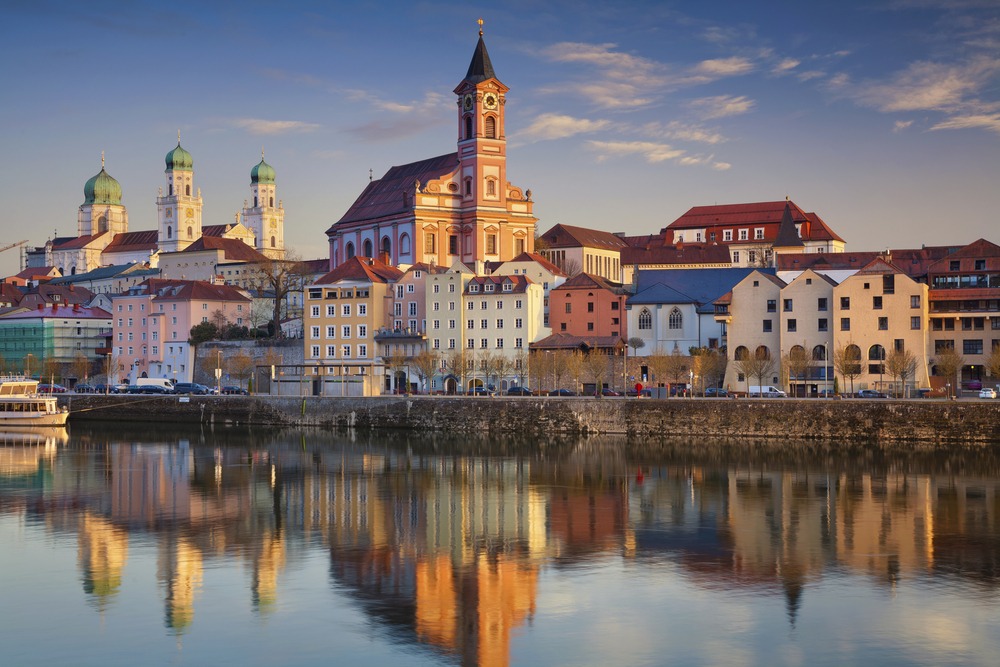Passau, Germany: A Historical Jewel at the Meeting of Three Rivers and Its Top 25 Attractions
Passau, often referred to as the “City of Three Rivers,” sits at the meeting of the Danube, Inn, and Ilz Rivers in southeastern Germany near the Austrian border. Its strategic position has made it a crossroads of trade, culture, and conflict since ancient times. The city’s roots date back to Roman times, when it was known as Batavis, a fortified outpost in the province of Noricum. Later, in the early Middle Ages, Passau grew in ecclesiastical significance with the establishment of the Diocese of Passau in 739, one of the oldest bishoprics north of the Alps. Throughout the centuries, it became one of the most influential bishoprics in the Holy Roman Empire, its prince-bishops ruling vast territories until the secularization in 1803.
Passau flourished as a center of trade in salt, wine, and shipbuilding. The baroque character that defines the city’s old town today was largely shaped by Italian architects after a devastating fire in 1662, resulting in grand churches, ornate facades, and narrow, winding alleys that evoke a Mediterranean ambiance. The most iconic of these is St. Stephen’s Cathedral, home to one of the largest pipe organs in the world. Passau’s resilience is etched into its stones—surviving wars, floods, and political upheavals while retaining a distinct charm that blends Bavarian tradition with cosmopolitan elegance.
Today, Passau is a beloved stop for Danube River cruises, a university town with a vibrant cultural scene, and a gateway to the Bavarian Forest. Its compact old town invites visitors to wander among pastel-hued buildings, scenic riverbanks, and storied landmarks.

Top 25 Attractions in Passau, Germany
-
St. Stephen’s Cathedral (Dom St. Stephan) – A baroque masterpiece featuring dazzling stucco work and the largest cathedral organ in the world with over 17,000 pipes.
-
Veste Oberhaus – This 13th-century fortress sits high above the Danube, offering panoramic views of the city and housing a museum tracing Passau’s history.
-
Old Town (Altstadt) – A maze of cobblestone alleys, colorful baroque buildings, and charming squares that reflect the city’s Italian influence.
-
Glass Museum Passau (Glasmuseum Passau) – Located in the historic Hotel Wilder Mann, this museum showcases the world’s largest collection of Bohemian glass.
-
Schaibling Tower (Schaiblingturm) – A medieval tower along the Inn River, once part of the city’s fortifications and a symbol of its resilience against floods.
-
St. Paul’s Church (Paulskirche) – The oldest parish church in Passau with Romanesque and Gothic elements and beautiful frescoes.
-
Dreiflüsseeck (Three Rivers Corner) – The geographic point where the Danube, Inn, and Ilz rivers converge, marked by dramatic color contrasts of the waters.
-
City Hall (Rathaus) – A neo-Gothic building noted for its ornate façade and the 15th-century tower with historical frescoes and flood level markers.
-
Passau Museum of Modern Art (Museum Moderner Kunst) – Housed in four historic buildings, it presents contemporary works by international and German artists.
-
St. Michael’s Church (Michaelskirche) – A former Jesuit church with a striking interior and connections to the early university history of Passau.
-
Artists’ Alley (Höllgasse) – A vibrant lane where local artists display their works in colorful studios, combining creativity with heritage.
-
St. Gertraud’s Church (Gertraudenkirche) – A hidden gem with a long religious history, nestled quietly near the banks of the Ilz River.
-
Ludwigsturm (Ludwig Tower) – An observation tower in the forested hills around Passau offering exceptional views of the city and the Alps on clear days.
-
Ilz River Promenade – A serene walking path along the “Black Pearl” of Passau, leading into dense woodland and scenic views.
-
Pilgrimage Church Mariahilf – Reached via a baroque covered staircase, this 17th-century church features religious art and sweeping views of Passau.
-
Passau University Campus – A blend of modern and historic architecture, the university injects youthful energy into the city and is worth a campus stroll.
-
Kloster Niedernburg – A Benedictine convent that became a girls’ school and is the burial place of Blessed Gisela of Hungary, wife of King Stephen I.
-
Schaiblingpark – A riverside green space perfect for a quiet rest or picnic with views of the Schaibling Tower and river traffic.
-
Passau Boat Tours – River cruises and ferry rides offer a unique perspective of the city’s skyline and bridges, especially enchanting at sunset.
-
Roman Museum Kastell Boiotro – Built over ancient Roman foundations, this museum explores Passau’s origins as a Roman military camp.
-
St. Severin’s Church and Cemetery – A quiet sanctuary with one of the city’s oldest cemeteries, offering a reflective detour into Passau’s early Christian past.
-
Künstlerhaus Hackl – A small museum and studio celebrating the legacy of local artist Fritz Hackl and traditional Bavarian arts.
-
Residenzplatz Square – A grand central square flanked by the Bishop’s Residence, with cafes and open-air events during the summer.
-
Ortspitze Park – Located at the tip of the peninsula where the three rivers meet, this is a tranquil park with walking paths and benches for river gazing.
-
Christmas Market at Cathedral Square (Christkindlmarkt) – A seasonal highlight offering handcrafted gifts, mulled wine, and Bavarian treats in a festive baroque setting.

Passau’s story is written in stone, water, and music. From its Roman origins to its baroque rebirth and vibrant modern life, the city offers an immersive journey through history and culture. Whether exploring its churches and fortresses or simply watching the rivers flow past in harmonious confluence, Passau is a destination of enduring allure.

































